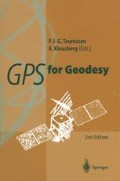Abstract
We saw in Chapter 3 that at a sufficiently large distance from a transmitter, the electromagnetic waves that it emits can be considered to be spherical. We can represent the electric field intensity of a spherical electromagnetic wave of frequency ω and wave number k at some distance r from the transmitter as
The signal from a GPS satellite when it arrives at a receiver can be taken to be such a wave and if we replace r by ρ, we can represent the signal in simplified form as
where A is the signal amplitude, t is the elapsed time measured from the start of transmission from the satellite, is the distance travelled from the satellite to the receiver, and ϕ′ is a phase bias term which is the phase of the wave at the satellite at t = 0.
Access this chapter
Tax calculation will be finalised at checkout
Purchases are for personal use only
Preview
Unable to display preview. Download preview PDF.
References
AGU (1994), 1994 Fall Meeting. EOS ,Vol. 75, No. 44, Supplement.
Bourassa, M. (1994,), Etude des Effets de la Variation des Centres de Phase des Antennes GPS. M.Sc. thesis, Département des Science Géodésiques et de Télédétection, Université Laval, Ste-Foy, PQ, Canada, 109 pp.
Braasch, M.S. (1994), “Isolation of GPS multipath and receiver tracking errors.” Navigation, Journal of the (U.S.) Institute of Navigation, Vol. 41, No. 4, pp. 415–434.
Braun, J., C. Rocken, and J. Johnson (1994), “Consistency of high precision GPS antennas.” Presented at the 1994 Fall Meeting of the American Geophysical Union ,San Francisco, CA, 5–9 December. Abstract: EOS, Vol. 75, No. 44, Supplement, p. 172.
Campbell, J. (1993), “Instrumental effects on the ionospheric rate of change observed by dual L-band GPS carrier phases.” Proceedings of the GPS/Ionosphere Workshop “Modelling the Ionosphere for GPS Applications,” Neustrelitz, Germany, 29–30 September, p. 78.
Cohen, C.E. (1992), Attitude Determination Using GPS: Development of an All Solid-state Guidance, Navigation, and Control Sensor for Air and Space Vehicles Based on the Global Positioning System. Ph.D. thesis, Department of Aeronautics and Astronautics, Stanford University, Stanford, CA, 184 pp.
Gurtner, W. (1994), “RINEX: The receiver-independent exchange format.” GPS World ,Vol. 5, No. 7, pp. 48–52.
Gurtner, W., M. Rothacher, S. Schaer, L. Mervart, and G. Beutler (1994), “Azimuth-and elevation-dependent phase corrections for geodetic GPS antennas.” Presented at the 1994 Fall Meeting of the American Geophysical Union ,San Francisco, CA, 5–9 December. Abstract: EOS, Vol. 75, No. 44, Supplement, p. 172. Hofmann-Wellenhof, B., H. Lichtenegger, and J. Collins (1994), Global Positioning System: Theory and Practice. 3rd edition. Springer-Verlag, Vienna, 355 pp.
Johnson, R.C. (Ed.) (1993), Antenna Engineering Handbook. 3rd edition. Mc-Graw Hill, Inc., New York, NY.
Langley, R.B. (1991), “The GPS receiver: An introduction.” GPS World ,Vol. 2, No. 1, pp. 50– 53.
Langley, R.B. (1993), “The GPS observables.” GPS World ,Vol. 4, No. 4, pp. 52–59.
Nagle, J.R., A.J. Van Dierendonck, and Q.D. Hua (1992), “Inmarsat-3 navigation signal C/A-code selection and interference analysis.” Navigation ,Journal of the (U.S.) Institute of Navigation, Vol. 39, No. 4, pp. 445–461.
RTCM (1994), RTCM Recommended Standards for Differential Navstar GPS Service. Version 2.1. RTCM Special Committee No. 104, Radio Technical Commission for Maritime Services, Washington, D.C., January.
Schupler, B.R. and T.A. Clark (1991), “How different antennas affect the GPS observable.” GPS World ,Vol. 2, No. 10, pp. 32–36.
Schupler, B.R., R.L. Allshouse, and T.A. Clark (1994), “Signal characteristics of GPS user antennas.” Navigation ,Journal of the (U.S.) Institute of Navigation, Vol. 41, No. 3, pp. 277–295.
Spilker, J.J., Jr. (1977), Digital Communications by Satellite. Prentice-Hall, Inc., Englewood Cliffs, NJ, 672 pp.
Spilker, J.J., Jr. (1978, 1980), “GPS signal structure and performance characteristics.” Navigation ,Journal of the (U.S.) Institute of Navigation, Vol. 25, No. 2, pp. 121–146 and reprinted in Global Positioning System -Papers Published in Navigation (Vol. I of “The Red Books”), Institute of Navigation, Alexandria, VA, pp. 29–54.
Stelzried, C.T. (1968), “Microwave thermal noise standards.” IEEE Transactions on Microwave Theory and Techniques ,Vol. MTT-16, No. 9, pp. 646–655.
Tranquilla, J.M., B.G. Colpitts, and J.P. Carr (1989), “Measurement of low-multipath antennas for TOPEX.” Proceedings of the Fifth International Geodetic Symposium on Satellite Positioning ,Las Cruces, NM, 13–17 March, Vol. I, pp. 356–361.
Van Dierendonck, A.J., P. Fenton, and T. Ford (1992), “Theory and performance of narrow correlator spacing in a GPS receiver.” Navigation ,Journal of the (U.S.) Institute of Navigation, Vol. 39, No. 3, pp. 265–283.
Van Dierendonck, A.J. (1995), “Understanding GPS receiver terminology: A tutorial.” GPS World ,Vol. 6, No. 1, pp. 34–44.
Ward, P. (1981), “An inside view of pseudorange and delta pseudorange measurements in a digital NAVSTAR GPS receiver.” Paper presented at the ITC/USA/’81 International Telemetering Conference on GPS Military and Civil Applications ,San Diego, CA, October.
Ward, P.W. (1994), “GPS Receiver RF Interference Monitoring, Mitigation, and Analysis Techniques.” Navigation ,Journal of the (U.S.) Institute of Navigation, Vol. 41, No. 4, pp. 367–391.
Wells, D., R. Langley, A. Komjathy, and D. Dodd (1995), Acceptance Tests on Ashtech Z-12 Receivers. Final report for Public Works and Government Services Canada ,February, 149 pp.
Yunck, T.P., S.C. Wu, S.M. Lichten, W.I. Bertiger, U.J. Lindqwister, and G. Blewitt, (1989), “Toward centimeter orbit determination and millimeter geodesy with GPS.” Proceedings of the Fifth International Geodetic Symposium on Satellite Positioning ,Las Cruces, NM, 13–17 March, Vol. I, pp. 272–281.
Author information
Authors and Affiliations
Editor information
Editors and Affiliations
Rights and permissions
Copyright information
© 1998 Springer-Verlag Berlin Heidelberg
About this chapter
Cite this chapter
Langley, R.B. (1998). GPS Receivers and the Observables. In: Teunissen, P.J.G., Kleusberg, A. (eds) GPS for Geodesy. Springer, Berlin, Heidelberg. https://doi.org/10.1007/978-3-642-72011-6_4
Download citation
DOI: https://doi.org/10.1007/978-3-642-72011-6_4
Publisher Name: Springer, Berlin, Heidelberg
Print ISBN: 978-3-642-72013-0
Online ISBN: 978-3-642-72011-6
eBook Packages: Springer Book Archive

